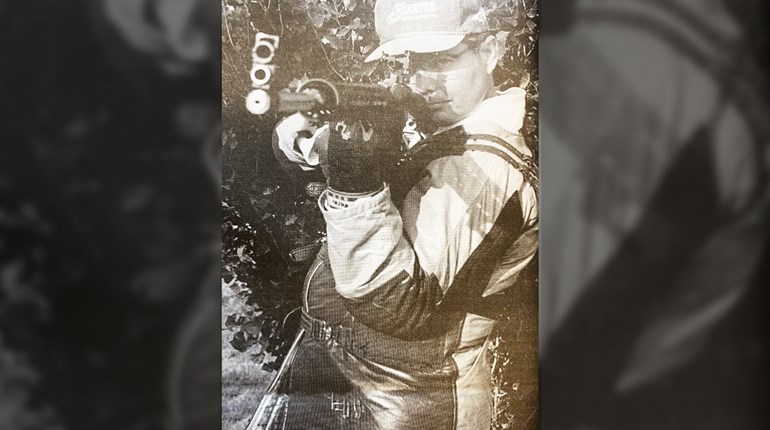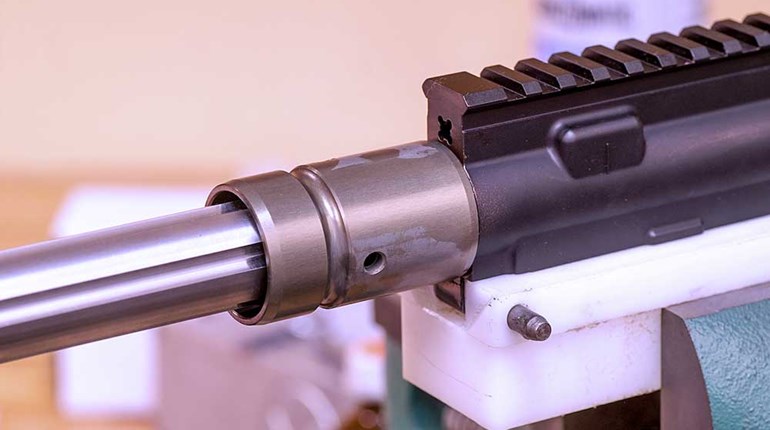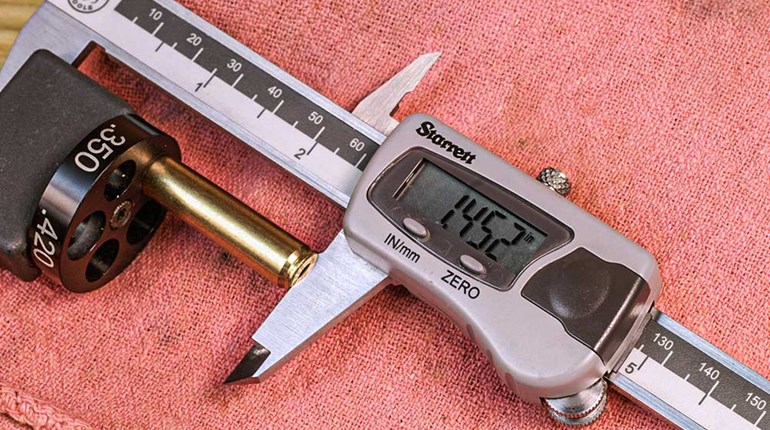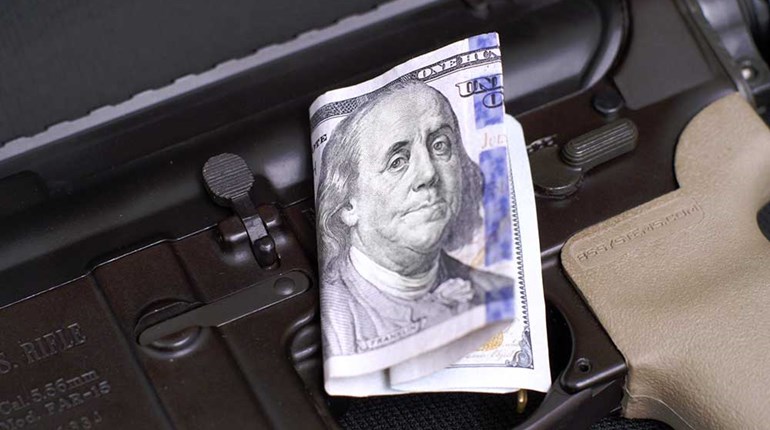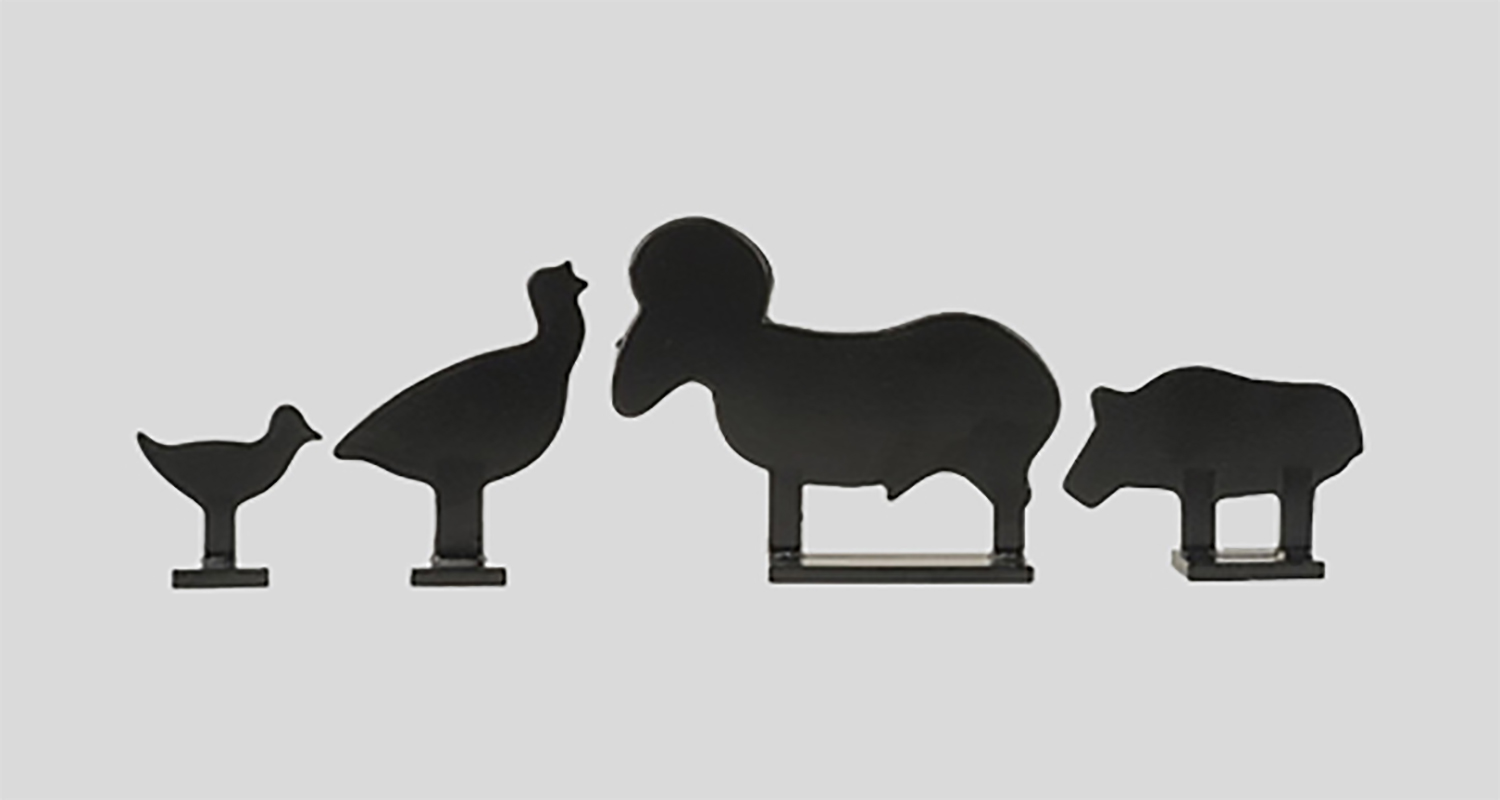
From the June 1991 issue of Shooting Sports USA.
On a windy 15-degree morning, I spotted for Lon Pennington at a local silhouette match. He was using a borrowed .22 revolver and hadn’t shot a freestyle silhouette match for 18 months, he finished 40x40. This intrigued me, and after thawing out and spending a few hours talking with Lon, I came a lot closer to understanding how he did that.
Background
Lon Pennington of Heber City, UT, had won 25 titles in handgun when he decided he wanted to become a metallic silhouette shooter. Lon saw a write-up in a magazine about the sport and decided that it looked like fun. So he bought some guns, built some targets, and taught himself to shoot it. One year later he won a title at the International Handgun Metallic Silhouette Association (IHMSA) Internationals.
His first experience in competitive shooting came from three years on the high school ROTC rifle team, but he was 34 years old before he owned a gun. Lon decided to go out to one of the local Canon City, CO turkey shoots. The game was five rounds for score at 600 yards. He won a turkey and ended up joining the club, and trying his hand at NRA High Power.
“When I read about silhouette shooting and decided that I wanted to try it, I had never even seen a match. I bought the guns and worked up some loads and drove to Ft. Collins, Colorado to an IHMSA match. We didn’t even know that they used spotters. I got out and got ready to shoot and everybody was trying to get my wife to come over and spot for me and neither of us knew what was going on."
“That match was in the summer of 1980, and I shot a Production 37x40 and a 39x40 Unlimited. The range was facing into the sun and I didn’t even have a hat. I think I could have fired a 40 but the sun and sweat were in my eyes.”
What had you been doing to practice for that first match?
“I hadn’t really been practicing, per se. I had made one of each target from steel so I’d have something to shoot at. It took me probably 250 rounds to get the loads worked up and get the zeros. As I was getting my loads and zeros, I was hitting the targets, so that was my practice. It’s really basic shooting, just like shooting a rifle prone—line up the sights and squeeze the trigger."
"But standing was a different matter; I shot a 15 in that first match. I was so nervous that I still remember having trouble getting the empty cases back into the ammo box because I was shaking so hard. That was my biggest obstacle, the nerves. But with more experience and a little less nervousness, the standing scores came up.”
And the scores came up very quickly. The next year he shot a standing 63x80 at the 1981 IHMSA Internationals, good enough for fourth. In 1981, Lon won Production and shot one of the two Production 80s fired that year. He then dropped out for a year and came back in 1983 to win Revolver with the only 80x80 using a Dan Wesson .357 SuperMag.
NRA Long Range Pistol
After winning his share of titles in IHSMA, Lon turned to the NRA-brand of silhouette competition for its greater challenge.
“The major IHSMA events had really become 10-shot matches. Everyone shot 80x80 in the tournament, and the real match came down to the shoot offs. I don’t think that 10 rounds is sufficient to determine a major championship…”
“The reason I started shooting NRA events was because of their half-size targets. It just intrigued me that there had never been a perfect score shot in a major tournament. The national record was 112x120. I thought maybe I could do better … My first NRA match was the regionals at Raton in 1985; the nationals that year were at Ft. Bliss. At Ft. Bliss, we were shooting east, and that was a struggle in the morning. That year we shot a 40-shot match for three consecutive days. I shot 39, 39, and finally, a 40 unlimited half-size when I got on an afternoon shift. I won with 118x120, which kind of disappointed me because I wanted a 120.”
He set new 40 and 80 round records for both Conventional and Unlimited half-size in 1985. “They dropped Conventional and Unlimited half-size that year, and I think they should have kept it.” That, after all, was the challenge.
He’s won Conventional Standing every year, and shot an 85x120 with a revolver, which is still the record. He’s won 13 total NRA titles, and holds the Conventional Standing record of 69x80. He also shot the first 80x80 on the half-size targets in 1989. Lon won both the aggregates in 1989, which is a 6-gun total. He won the Freestyle Aggregate with 319x320, and the Standing Aggregate with 140x160. The only NRA title he hasn’t held is Unlimited Standing, “I haven’t shot much with a scope, and that takes practice …”
Practice
Lon, in any traditional sense of the word, doesn’t practice: “Shooting matches is the best practice there is.” He only dry-fires a little bit, “too boring,” he says. And he takes the guns out of their cases fewer than a dozen times a year.
“After the last big match in a season, I’ll lay down the guns and not fire a shot for six months I just get burned out."
“I shot 18 matches the first year I competed. Since that first year, I’ve shot about six matches a year. And the funny thing is that I have managed to get better.”
“But I go prepared. I do my homework by seeing what the guns are doing before the match. With the actual batch of ammo I will shoot, I go out before every match and check zeros. If I can go out by myself and lay down and put a nice tiny group in the center of the target, I know I can go out and do it in a match.”
“It’s very critical to get your zeros, and a lot of people don’t really spend the time they should doing that. I’ll shoot however many shots I need until I’m satisfied that the gun is grouping and hitting where I want. So when I practice, that’s really all I’m doing. I don’t practice shooting the match. If I have some ammunition left over from zeroing, I’ll shoot a few rounds standing, but that’s the extent of my actual practice.”
“One thing I’ve been remiss in is that I keep very poor notes. It would really help to keep good notes because you think you can keep things in your head, but you can’t. I could have done a little better here and there if I kept really good notes. I’m getting better about this, but you should take the advice and keep notes on loads, zeros, temperatures, and so on. Especially with shooting so many guns, there’s too much to trust to memory.”
Loads and Accuracy
Since this is the area where Lon concentrates his "practice" prior to a match, we thought you’d like to know what he’s looking for when he takes that infrequent trip to the local range.
“Purely accuracy-group size—but of course, with a heavy enough bullet. When I start working up a load, I know that I’m already going to beat a level where the power is there, so I look for the load that shoots the best.”
“The .357 SuperMag is a good example. The first load worked up was marginal in power but I think I could find a better load. It was with a relatively light 180 grain bullet and grouped 2 inches horizontally at 50 yards, but is also grouped with a vertical dispersion of under 1 inch, and those were for 10-shot groups; I knew that I had to use it because I knew I could keep it on the rams.”
“I got lucky at the Internationals, but I lost rams with that load at club matches, so I went to 200 grain bullets for the next Internationals. The load I use now, and have used since 1983, will normally group 5 shots at 50 yards in 1.5 inches, or less, with iron sights. Anytime I can get a revolver to group like that, I know I can shoot an 80 with it.”
“But the 1.5 inch 50 yard group translates to 6 inches at 200 meters, and that’s for a 5-shot group. For 10-and 20-shot groups, which is really what you’re firing in a match, then the gun almost has to shoot that well to be able to clean the targets. The idea of group sizes varying with the number of shots fired is something that most people don’t seem to understand."
“Most people think their gun will shoot better than it actually does because they tend to count on their best-ever group to be what they can rely on, and to disregard the bad groups as being flukes, whereas the best group really may be the fluke. Do your homework on your loads and zeros, and don’t chase your sighters around, especially with a revolver. Most revolvers aren’t very accurate, and people have to learn to accept the hits that are out there on the edge of the targets and just keep shooting for the center. Keep a long-run average going in your brain.”
“Of course, you want to see a smaller group with an Unlimited gun. I look for one-hole groups but I never get them. I expect to consistently shoot 1 inch freestyle at 50 yards. But I don’t really group the Unlimited gun that much; I usually test it by shooting chickens at 200 meters so I’ll have a good shoot off sight setting. If I can hit 9 out of 10, that’s good enough. But it takes that to win …” “In the 1985 NRA championships in a daily shoot off, Ron Cottriel and I have tied with 39s on the half-sized targets. The shoot off was on half-sized chickens at 150 meters. We both hit 4/5 the first time; they reset them and I got 5/5 and edged him out by one target. It took 9/10 to win that year, so the gun’s got to be capable. Half-sized chickens are about a 3-inch circle, which is about 2 minutes of angle at 150. That’s the edge of the accuracy, that’s all I’m good for.”
“In the 1985 NRA championships in a daily shoot off, Ron Cottriel and I have tied with 39s on the half-sized targets. The shoot off was on half-sized chickens at 150 meters. We both hit 4/5 the first time; they reset them and I got 5/5 and edged him out by one target. It took 9/10 to win that year, so the gun’s got to be capable. Half-sized chickens are about a 3-inch circle, which is about 2 minutes of angle at 150. That’s the edge of the accuracy, that’s all I’m good for.”
“The gun itself, though, should be capable of at least 0.5 minute accuracy, sandbagged. You’re giving up too much if your Unlimited gun won’t shoot that well. With a 2 minute Unlimited, you’re still going to shoot an 80, but that’s not good enough to hit shoot off targets.”
“You’ll hear a lot of silhouette shooters remark, ‘Well, it shoots better than I do … That doesn’t mean that it’s good enough. You need to reduce the mechanical error as much as possible. A gun that shoots 2 minutes may be a fairly accurate gun, but compared to one that shoots 0.5 minutes, you’re giving up 3 inches of shooter holding error (1.5 on either side of target center) at 200 meters. On a normal shoot off target—half-sized chickens at 150-a 2 minute gun has already used up the entire target, there is no room for any shooter error at all. If you’re in a shoot off against someone who’s as good as you are and their gun shoots that much better, forget it."
“I struggled for years with a factory Remington XP that I could shoot 40s with consistently, but I didn’t do well in shoot offs because the gun was not very accurate; it had a lot of little things wrong with it. In the winter of 1984, I fitted the gun with a heavy Hart barrel. I built a 6-ounce stock and lightened the action so that half the weight of the gun was in the barrel. I went out that next season and won Unlimited at the Internationals. And with that gun I then went on for two years virtually undefeated and started setting records. And that was because the gun really shot well, I couldn’t have done it with an ordinary gun. It amazed me how much difference that extra accuracy makes."
“I test every new batch of components to make sure that my velocities stay consistent. If I have a load that performs best at 1500 FPS, that’s the velocity I need to see. It’s a big mistake to assume that your load won’t change when you restock your components.”
Thoughts on the Sport
Lon came to the NRA-brand of shooting for the greater challenge of the half-sized targets. There is currently a lot of rhetoric going on in silhouette shooting as to what should be done to insure the health of the game. Especially in the IHSMA organization, there has been some talk that has revolved around making the sport easier to encourage shooters to stay in it. Lon believes that’s wrong thinking.
“I’d like to see half-sized targets for every freestyle division at the major matches. I think that a shooting event should be won in the match itself rather than in the shoot offs. I also think that clubs should think about offering a half-sized option at local matches. I know of a couple that are doing that, and they’re reporting better interest from their shooters, not lower interest."
“It’s easy for me to compare this whole issue to what’s happened in other sports, and the 4-minute mile is a good example. Once that was broken, then many others followed. And the same thing even happened in .22 position rifle shooting. They reduced the size of the target and the shooters struggled at first but are now back to cleaning them occasionally. I think it’s wrong not to challenge a shooter to just hit whatever targets are out there. That’s the whole fun of a sport. If you want to set up the rules so everyone can hit all the targets, then there’s no incentive to do better, there’s no challenge. If there’s no challenge, there’s no sport.”
Equipment
Conventional: MOA chambered in 7 TCU; 10-inch barrel.
Revolver: Dan Wesson VH8S chambered in .357 SuperMag (aka .357 Maximum).
Unlimited: XP100 chambered in 7 BR; custom stock; Hart barrel; Williams Target receiver sight or 4x Weaver or 7x Burris IER scope.
.22: Thompson Center Contender; 10-inch barrel.













